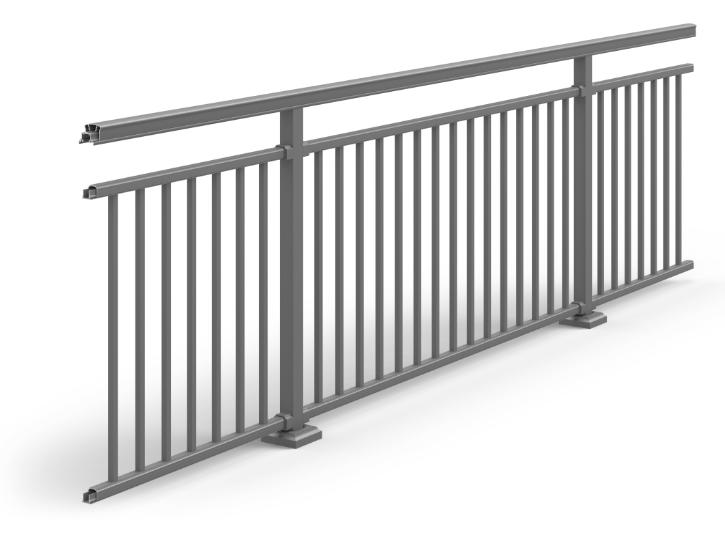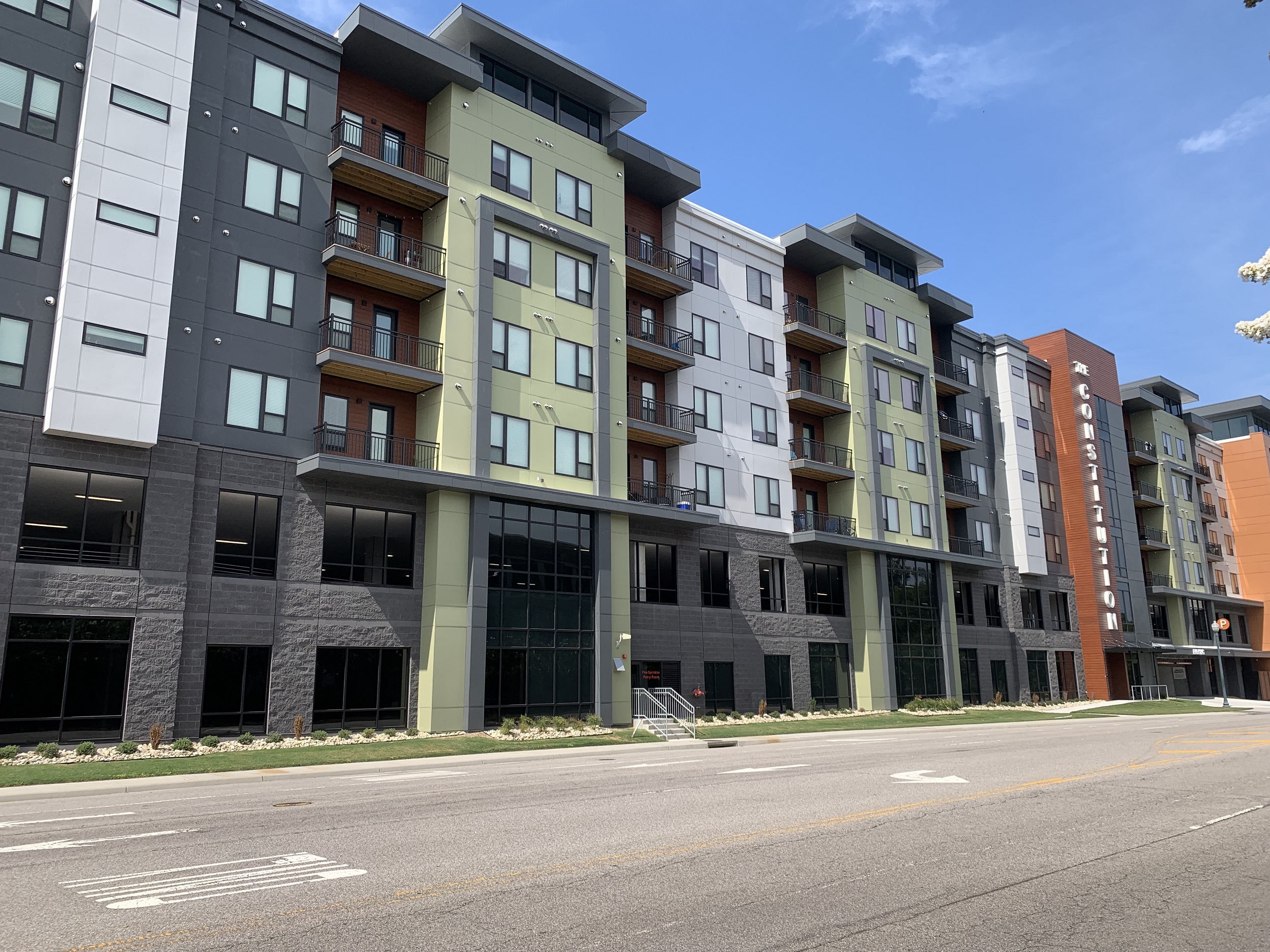Ultra Aluminum Mfg., Inc. recently supplied its Ultra Signature aluminum railing for the balconies at The Constitution (City View II) in Virginia Beach, VA. Clancy & Theys Construction Company selected John Patterson with Brothers Fence and Rail to install the aluminum railing for its project. Mr. Patterson stated, “we selected the Ultra Aluminum railing because it is easy to install, much lighter than steel railing and not subject to the corrosion associated with steel railing this close to the salt water. Plus, it was competitively priced and the engineering staff at Ultra assisted with the required submittals and project quote.”
Ultra Aluminum Mfg., Inc. is based in Howell, MI and has been focused on producing quality aluminum fence and rail for nearly 25 years. As a leader in the industry, Ultra Aluminum has been focused on the multi-family industry for the past 8 years because they can supply the balcony railing, pool fence, dumpster enclosures and privacy panels around the generators and HVAC equipment. Ultra Aluminum powder coats all its products to the AAMA2604 specifications and offers a 10-year commercial warranty, another differentiator when compared to steel railing products.
The railing used at The Constitution was UARC 270 3-rail continuous with the Franklin top profile seen below:

Ultra Aluminum railing products are engineered to exceed the IRC and IBC requirements for “guard rail” and is a favorite among installing contractors due to its installation simplicity. The Constitution project had balcony railing on its exterior as well as in the courtyard providing its’ residents with a safe balcony space to enjoy the year-round climate in the Virginia Beach region.

As stated earlier, Ultra Aluminum can create submittals and a project quote for the installing contractors from the project plans they provide. Ultra has a network of installation partners, like Brothers Fence and Rail throughout the United States should the Developer and/or General Contractor need turnkey proposals.
The building industry is seeing a dramatic change in materials used for multi-family railing. For years wood was the material of choice but began changing to vinyl and steel in the 1980’s. In the past two decades aluminum has been the fastest growing material used for fence and railing due to its life expectancy, low maintenance, installation ease and competitive pricing.
Should you need a railing or fence partner for upcoming multi-family projects consider reaching out to Ultra Aluminum Mfg., Inc. at 800-656-4420. Their websites are great resources as well: www.ultrarailing.com and www.ultrafence.com.
Related Stories
Resiliency | Sep 3, 2024
Phius introduces retrofit standard for more resilient buildings
Phius recently released, REVIVE 2024, a retrofit standard for more resilient buildings. The standard focuses on resilience against grid outages by ensuring structures remain habitable for at least a week during extreme weather events.
Products and Materials | Aug 31, 2024
Top building products for August 2024
BD+C Editors break down August's top 15 building products, from waterproof wall panel systems to portable indoor pickleball surface solutions.
Adaptive Reuse | Aug 29, 2024
More than 1.2 billion sf of office space have strong potential for residential conversion
More than 1.2 billion sf of U.S. office space—14.8% of the nation’s total—have strong potential for conversion to residential use, according to real estate software and services firm Yardi. Yardi’s new Conversion Feasibility Index scores office buildings on their suitability for multifamily conversion.
Adaptive Reuse | Aug 28, 2024
Cities in Washington State will offer tax breaks for office-to-residential conversions
A law passed earlier this year by the Washington State Legislature allows developers to defer sales and use taxes if they convert existing structures, including office buildings, into affordable housing.
Affordable Housing | Aug 27, 2024
Not gaining community support is key barrier to more affordable housing projects
In a recent survey, builders and planners cited difficulty in generating community support as a key challenge to getting more affordable housing projects built. The survey by coUrbanize found that 94% of respondents tried to gain community input and support through public meetings, but many were frustrated by low attendance. Few respondents thought the process was productive.
Adaptive Reuse | Aug 22, 2024
6 key fire and life safety considerations for office-to-residential conversions
Office-to-residential conversions may be fraught with fire and life safety challenges, from egress requirements to fire protection system gaps. Here are six important considerations to consider.
Multifamily Housing | Aug 21, 2024
Nation's leading multifamily developer expands into infrastructure
Greystar's strategy for infrastructure is driven by the shifting landscape of today's cities—primarily in the increased digitization, urbanization, and transitions to clean energy.
MFPRO+ New Projects | Aug 20, 2024
Seattle workforce housing project inspired by geology of eastern Washington
J.G. Whittier Apartments, a workforce housing project in Seattle uses the geology of eastern Washington as inspiration for the design. The architecture and interior design celebrate geometric anomalies found in nature. At the corners of the building, blackened wood siding “erodes” to expose vibrant murals underneath.
MFPRO+ New Projects | Aug 16, 2024
At 60 stories, the Paramount multifamily development will stand as Nashville’s tallest high rise
When complete, the 60-story Paramount building, at 750 feet high, will be the tallest high rise tower in Nashville, Tenn., surpassing the city’s current record holder, the 617-foot AT&T Building. The $390 million Paramount project recently launched condo sales after securing more than $230 million in construction financing.
Curtain Wall | Aug 15, 2024
7 steps to investigating curtain wall leaks
It is common for significant curtain wall leakage to involve multiple variables. Therefore, a comprehensive multi-faceted investigation is required to determine the origin of leakage, according to building enclosure consultants Richard Aeck and John A. Rudisill with Rimkus.
















